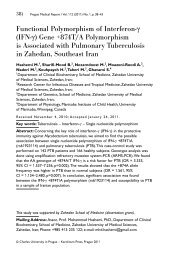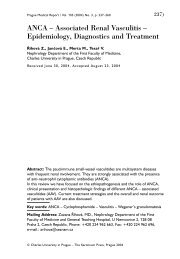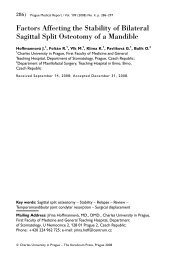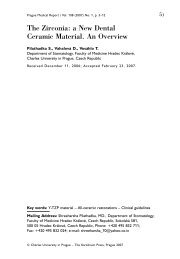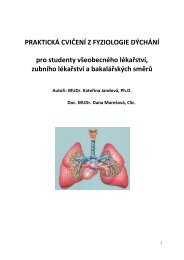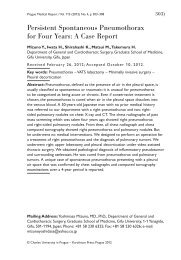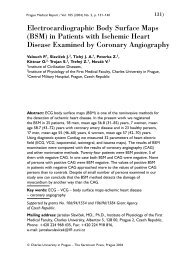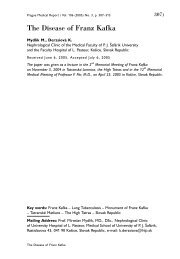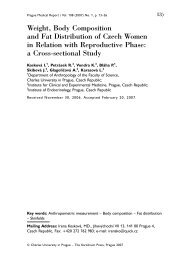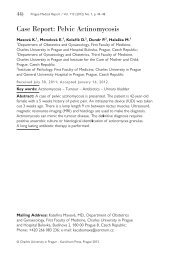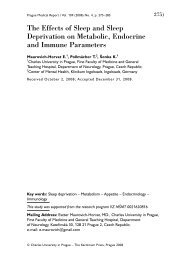here - Prague Medical Report
here - Prague Medical Report
here - Prague Medical Report
Create successful ePaper yourself
Turn your PDF publications into a flip-book with our unique Google optimized e-Paper software.
<strong>Prague</strong> <strong>Medical</strong> <strong>Report</strong> / Vol. 106 (2005) No. 2, p. 149–158<br />
Changing © Charles of University Facial Skeleton in <strong>Prague</strong> for Treatment – The Karolinum of OSAS Press, <strong>Prague</strong> 2005<br />
149)<br />
Changing of Facial Skeleton for Treatment<br />
of Obstructive Sleep Apnoea Syndrome<br />
Foltán R. 1 , Pretl M. 2 , Donev F. 1 , Hoffmannová J. 1 ,<br />
Vlk M. 2 , Šonka K. 2 , Mazánek J. 1 , Rambousek P. 3<br />
1 Department of Stomatology of the First Faculty of Medicine,<br />
Charles University in <strong>Prague</strong>, and General Teaching Hospital, Czech Republic;<br />
2 Department of Neurology of the First Faculty of Medicine,<br />
Charles University in <strong>Prague</strong>, and General Teaching Hospital, Czech Republic;<br />
3 ENT Department of General Teaching Hospital in <strong>Prague</strong>, Czech Republic<br />
Received May 16, 2005, Accepted June 15, 2005<br />
Abstract: Obstructive sleep apnoea syndrome (OSAS) is a potentially<br />
life-threatening disorder. It is characterized by at least five episodes of apnoea<br />
or hypopnoea during sleep lasting for more than 10 seconds. Apnoea or<br />
hypopnoea are accompanied by respiratory efforts. Changes of the facial skeleton<br />
by mandibular or maxillo-mandibular advancement belong to surgical techniques<br />
which might affect moderate and severe OSAS. In the surgical procedure mandible<br />
alone or the upper and lower jaws are moved forward by at least 10 mm. Thus<br />
also muscles fixed to the facial skeleton and upper airway dilatators are moved<br />
forward. The discussion also mentions possible complications and limitations<br />
of this surgical technique.<br />
Key words: Facial skeleton – Obstructive sleep apnoea syndrome –<br />
Maxillo-mandibular advancement – Upper airway dilatation – Stability<br />
The project was supported by grant IGA MZ ČR NR8038-3.<br />
Mailing Address: René Foltán, MD., DMD., Department of Stomatology of the<br />
First Faculty of Medicine, Unit of Oral and Maxillofacial Surgery, U nemocnice 2,<br />
128 00 Praha 2, Czech Republic, Phone: +420 224 962 729,<br />
Fax: +420 224 962 153, e-mail: renefoltan@seznam.cz
150) <strong>Prague</strong> <strong>Medical</strong> <strong>Report</strong> / Vol. 106 (2005) No. 2, p. 149–158<br />
Introduction<br />
Obstructive sleep apnoea syndrome (OSAS) is a potentially life-threatening<br />
disorder [1] affecting in the USA, for example, up to 18 million people [2]. It is<br />
characterized by at least five episodes of apnoea or hypopnoea lasting for more<br />
than 10 seconds per hour of sleep. Apnoea and hypopnoea are accompanied by<br />
respiratory efforts. If the effort is missing it is central apnoea.<br />
Obstruction in the upper airway may occur at the level of velopharyngeal area<br />
(Fujita type I) or at the level behind the tongue base (Fujita type III) and/or<br />
concurrently at both levels (Fujita type II) [3].<br />
Craniofacial abnormalities could be among the causes of airway obstructions;<br />
however, usually it is impossible to find an unambiguous pathology leading to this<br />
disorder.<br />
According to the number of apnoea and hypopnoea episodes per hour of sleep<br />
(respiratory disturbance index – RDI) OSAS can be classified as mild OSAS<br />
(RDI 5–15), moderate OSAS (RDI 15–30) and severe OSAS (RDI> 30).<br />
Both surgical and non-surgical techniques are used to treat the disorder.<br />
Non-surgical treatment for mild and moderate OSAS consists of changes<br />
in the sleep habits (sleep hygiene) or using lower jaw positioners. Severe OSAS<br />
requires the use of a device delivering air with elevated pressure to upper<br />
airway during sleep (continuous positive airway pressure – CPAP or bi-phasic,<br />
which pressure fluctuates depending on the respiration). The device could also<br />
have an autotitration feature when the pressure is regulated based<br />
on the current resistance in the upper airway. Pressure effect is fully curative<br />
for OSAS [4].<br />
All the above devices require fixed mounting of a nasal breathing mask<br />
throughout the whole duration of the sleep. This is unacceptable for some<br />
patients for various reasons. Also, patients with a hypoplastic lower jaw show<br />
low compliance. For them, pressure in the upper airway is heavily<br />
uncomfortable [5].<br />
Surgical techniques extend the upper airway by various mechanisms. Table 1 [6]<br />
gives success rates of individual surgical techniques.<br />
In mild and moderate OSAS we modify the airway depending on the location<br />
of obstruction by uvulopalatopharyngoplasty – UPPP (obstruction of Fujita type I)<br />
or genioglossus advancement and hyoid myotomy – GAHM (obstruction of Fujita<br />
type III) [7].<br />
Surgical treatment which might affect severe OSAS includes only permanent<br />
tracheotomy, maxillo-mandibular advancement and in case of mandibular<br />
hypoplasia just mandibular advancement. T<strong>here</strong> are strict indication criteria<br />
available for use of tracheotomy and this technique is used only rarely in practice<br />
(see Table 2) [8]. Mandibular and maxillo-mandibular advancements represent<br />
a socially well accepted solution. Our indication for use of maxillo-mandibular<br />
advancement and mandibular advancement see Tables 3 and 4.<br />
Foltán R.; Pretl M.; Donev F.; Hoffmannová J.; Vlk M.; Šonka K.; Mazánek J.; Rambousek P.
<strong>Prague</strong> <strong>Medical</strong> <strong>Report</strong> / Vol. 106 (2005) No. 2, p. 149–158<br />
Table 1 – Overview of surgical treatment success rate for OSAS<br />
(in %) [6]<br />
Changing of Facial Skeleton for Treatment of OSAS<br />
151)<br />
Surgery Obstruction Localisation Success Rate*<br />
UPPP type I 74.6%<br />
GAHM type II 67.0%<br />
UPPP + GAHM type II 83.3%<br />
GAHM type III 85.7%<br />
MMA type I–III 94.7–100%<br />
Tracheotomy type I–III 100.0%<br />
*Success rate of the treatment is defined as RDI decrease to at least a half, however at most to 20, and<br />
increase of the average oxyhemoglobine desaturation by a half, however at least to 90%. List of acronyms:<br />
UPPP – uvulopalatopharyngoplasty, GAHM – genioglossus advancement and hyoid myotomy.<br />
Table 2 – Tracheotomy indication by Fujita [8]<br />
Apnoea accompanied by bradycardia (pulse 50 ml)<br />
OSAS with cor pulmonale<br />
Table 3 – Indication criteria for maxillo-mandibular advancement<br />
1. Manifested moderate or severe OSAS (RDI>15, decrease in the lowest saturation below<br />
90%, manifested excessive daytime sleepiness).<br />
2. Treatment by pressure in the upper airway is not successful or not tolerated by the patient.<br />
3. Patient does not suffer from a severe internal disease (ASA15, decrease in the lowest saturation below<br />
90%, manifested excessive daytime sleepiness).<br />
2. Treatment by pressure in the upper airway is not successful or not tolerated by the patient.<br />
3. Patient does not suffer from a severe internal disease (ASA
152) <strong>Prague</strong> <strong>Medical</strong> <strong>Report</strong> / Vol. 106 (2005) No. 2, p. 149–158<br />
Surgical Technique of Maxillo-mandibular Advancement<br />
The principle of this surgical treatment for an OSAS patient was described for<br />
the first time in 1979 [9]. It is shown in Figure 1.<br />
Preoperative orthodontic preparation help to adjust the patient’s dental arches<br />
in order the maximal intercupsidation is achieved. The fixed orthodontic device<br />
together with a surgical arch is applied to improve further the oral architecture.<br />
The surgical arch is then used during and after the surgery for stabilization and<br />
immobilization through elastic intermaxillary fixation.<br />
Standard preparation is performed similarly to any orthognathic surgery.<br />
The surgery is first simulated on a lateral cephalogram. The movement<br />
of the upper jaw is at least 10 mm anteriorly and we also plan possible reclining<br />
of the occlusal level in accordance with the size of the gonion angle and the smile<br />
line. Reclining angle is always around 3 to 5 degrees in the clock wise motion.<br />
Then, we make impressions of the patient’s upper and lower teeth and register<br />
intermaxillary relations and the gradient of the articular path by a facial arch. This<br />
registration is then transferred to the articulator adjusted individually. We simulate<br />
the surgery in a lab using a plaster model with relevant movements in the<br />
articulator. Thus we make two splints.<br />
A peroperative splint will help us to locate exactly the upper dental arch relaxed<br />
in the line of Le Fort I against the rigid lower dental arch. The postoperative splint<br />
is then made in accordance with the planned habitual occlusion.<br />
Figure 1 – Principle of the maxillo-mandibular<br />
advancement.<br />
Foltán R.; Pretl M.; Donev F.; Hoffmannová J.; Vlk M.; Šonka K.; Mazánek J.; Rambousek P.
<strong>Prague</strong> <strong>Medical</strong> <strong>Report</strong> / Vol. 106 (2005) No. 2, p. 149–158<br />
Changing of Facial Skeleton for Treatment of OSAS<br />
153)<br />
The surgery is performed under general anaesthesia with a naso-tracheal<br />
intubation.<br />
The surgery starts with osteotomy of the upper jaw in the Le Fort I line<br />
extended also to the caudal part of the processus pterygoideus. Having cut off<br />
the nasal septum, down fracture and mobilised the lower fragment of the upper<br />
jaw together with the upper dental arch we move this released fragment<br />
together with the muscular insertions of the soft palate forward by 10 mm with<br />
a 3-mm caudal inclination in the anterior part. Thus we also expand the capacity<br />
of the nasal cavity and velopharyngeal isthmus. Osteotomy is performed as low<br />
as possible to avoid excessive postoperative change of the paranasal area,<br />
however at least 5 mm above the apexes of upper teeth. A peroperative splint<br />
into which we temporarily fix dental arches using wire intermaxillary fixation will<br />
determine the size and direction of the movement. We fix the moved fragment<br />
of the upper jaw with the dental arch in the new position with four titanium mini<br />
splints and a total of 16 titanium screws in the area of paranasal and<br />
infrazygomatic pillars.<br />
Following fixation of the upper segment we remove the temporary wire<br />
intermaxillary fixation and perform bilateral sagittal osteotomy of the lower jaw<br />
ramus (sec. Obwegeser or sec. Epker). The anterior section is placed on corpus<br />
mandibulae as anteriorly as possible, approximately in the area of the first molar<br />
teeth. Having split the bone using the Obwegeser technique we perform bilateral<br />
mobilization of the anterior segment of the lower jaw together with the lower<br />
dental arch. Then we move the fragment forward and slightly autorotate in order<br />
to achieve maximum occlusion. The occlusion is again temporarily fixed by<br />
postoperative splint and rigid intermaxillary fixation. Anterior motion of the lower<br />
jaw expands the retrolingual area and removes potential obstructions at this level.<br />
To fix all mandibular fragments in the new position we use bilaterally two titanium<br />
mini-plates and four to six titanium mini-screws. Postoperative rigid intermaxillary<br />
fixation is not necessary and in principle we do not perform it. Instead, we use<br />
light neutral elastic intermaxillary fixation. Finally, we perform genioplasty<br />
according to Kölle with our tenon and mortise modification w<strong>here</strong>by we achieve<br />
even greater expansion of the retrolingual area by anterior advancement<br />
of the mm. genioglossus. This sliding osteotomy of the chin is also fixed<br />
by titanium mini-plates.<br />
Due to possible alteration of the upper airway by oedema we closely monitor<br />
the patient the first 24 hours after the surgery at the postoperative recovery unit.<br />
In the postoperative period, fluid diet must be supplied for three weeks followed<br />
by three-weeks of the soft diet.<br />
Should t<strong>here</strong> be no improvement in the ventilation parameters following the<br />
surgery, some authors recommend also GAHM (genioglossus advancement and<br />
hyoid myotomy) or UPPP (uvulopalatopharyngoplasty) in the second phase or both<br />
interventions concurrently.
154) <strong>Prague</strong> <strong>Medical</strong> <strong>Report</strong> / Vol. 106 (2005) No. 2, p. 149–158<br />
Mandibular advancement<br />
During this operation, only mandible is moved anteriorly. The natural growth<br />
deficit of the mandible is thus compensated. The mandible is moved anteriorly<br />
after bilateral sagittal split osteotomy of the ramus as describe above. Together<br />
with the mandible also the extraglossal muscles are moved resulting in widening of<br />
the upper airway.<br />
As the hypoplastic mandible is almost always accompanied by a wrong position<br />
of individual teeth, it is necessary to decompensate this malocclusion before<br />
the mandibular advancement with the orthodontic therapy (fixed orthodontic<br />
appliances). This therapy involves removal of compensatory angle of upper and<br />
lower teeth by fixed orthodontic apparatuses. This process is called<br />
decompensation and its main task is to fix teeth in both jaws in ideal positions.<br />
The mutual maximum intercuspidation is then reached by mandibular<br />
advancement. Figure 2 demonstrates the change of dimensions of the upper<br />
airway on lateral cephalograms and photos after orthodontic decompensation and<br />
Figure 2 – Patterns of upper airways on lateral cephalograms and photos of the patient before treatment,<br />
after the orthodontic decompensation and after the mandibular advancement.<br />
Foltán R.; Pretl M.; Donev F.; Hoffmannová J.; Vlk M.; Šonka K.; Mazánek J.; Rambousek P.
<strong>Prague</strong> <strong>Medical</strong> <strong>Report</strong> / Vol. 106 (2005) No. 2, p. 149–158<br />
Changing of Facial Skeleton for Treatment of OSAS<br />
155)<br />
mandibular advancement. As demonstrated also by our work [10] this operation<br />
expands not only the retrolingual space, but also the retrovelopharyngeal space as<br />
the soft palate is more vertical and it tilts from the dorsal nasopharyngeal wall.<br />
Discussion<br />
As it has been repeatedly stressed the maxillo-mandibular advancement treatment<br />
is reserved for cases of severe OSAS and for patients whose upper airway<br />
dimensions have been affected by an anomaly of their facial skeleton. The main<br />
advantage of this treatment is the possibility of widening both the retrolingual and<br />
velopharyngeal space with the possibility of extending also the nasal cavity volume.<br />
Its high success rate (approx. 94.7–100%) is an advantage. That is why some<br />
authors recommend this method as the only acceptable surgical technique for<br />
OSAS treatment [11]. Based on our opinion and experience, mild and moderate<br />
OSAS can be quite successfully treated with other surgical techniques such as<br />
GAHM or UPPP [7].<br />
On the other hand, this method is quite demanding for the surgeon and it results<br />
in a change of the patient’s facial type. The change in appearance is quite dramatic.<br />
Figure 3 shows lateral cephalograms of the patient before and after the maxillomandibular<br />
advancement. The postoperative cephalometry values indicate a<br />
Figure 3 – Lateral cephalogram of the patient before and after the maxillo-mandibular advancement.
156) <strong>Prague</strong> <strong>Medical</strong> <strong>Report</strong> / Vol. 106 (2005) No. 2, p. 149–158<br />
significant bimaxillar protrusion. Our patient accepted the change very well and in<br />
a positive manner, may be also thanks to a significant improvement of his general<br />
state. However, it can be stated that in general the change is always aesthetically<br />
acceptable [12, 13] due to the mechanism of the surgery representing a reverse<br />
face lift (soft facial tissues are not stretched on the facial bones, but the facial<br />
bones are pressed against the soft tissues). The decision-making process is<br />
certainly made easier by the use of predictive simulation programmes allowing<br />
simulating a probable postoperative appearance of the patient. Due to extensive<br />
movement of the fragments caution should be applied in particular in slim patients<br />
with a thin layer of soft facial tissue envelope. In this case, a very unsightly<br />
deficiency of labial closure could develop.<br />
Postoperative monitoring at the postoperative recovery unit is also very<br />
important. Patients suffering from OSAS are frequently polymorbid and thus it is<br />
important to take their overall condition into consideration when indicating<br />
a treatment. Risks according to ASA 3 and 4 represent, in our opinion,<br />
a contraindication. In these patients we indicate a non-surgical therapy using<br />
CPAP. We also believe that obesity with BMI over 29 kg/m 2 represents<br />
a contraindication [14].<br />
References state severe postoperative oedema in the upper airway requiring<br />
a long-term intubation or even tracheotomy as a possible complication. Later<br />
complications include mainly a relapse [15] resulting in a loss of the maximum<br />
occlusion. Some authors use bone inlays between osteotomies.<br />
Frequently described complications are dysfunctions of the temporo-mandibular<br />
joint. Kerstens et al. [16] in his publication on the influence of orthognathic surgery<br />
on the temporo-mandibular joint states, that in 11.5% of patients out of a total of<br />
480 he observed development of new symptoms evidencing different types of<br />
temporo-madibular dysfunctions. On the other hand, 2/3 of patients who suffered<br />
from some type of temporo-mandibular dysfunctions before the surgery had no<br />
problems after the orthodontic surgery. Similar results can be found also in a study<br />
by White and Dolwick [17] describing 7.9% of new postoperative temporomandibular<br />
dysfunctions in 296 treated patients, but almost a 90% success rate<br />
in removing preoperative temporo-mandibular defects. The truth is that despite<br />
significant efforts we were unable to find a valid study on this complication<br />
particularly in OSAS patients after MMA. However, this complication must be<br />
taken into account in the future and the patient must be informed about it within<br />
the preoperative informed consent.<br />
Recent references mention cases of performing maxillo-mandibular<br />
advancement gradually through the distraction osteogenesis [18]. The principle of<br />
the operation remains the same, osteotomy is performed as mentioned above,<br />
but the fragments are not moved anteriorly, but distractors are attached<br />
to the bones. They represent simple devices based on a principle of expandable<br />
bolt. Bones in the place of the osteotomy are gradually moved away by sequence<br />
Foltán R.; Pretl M.; Donev F.; Hoffmannová J.; Vlk M.; Šonka K.; Mazánek J.; Rambousek P.
<strong>Prague</strong> <strong>Medical</strong> <strong>Report</strong> / Vol. 106 (2005) No. 2, p. 149–158<br />
Changing of Facial Skeleton for Treatment of OSAS<br />
157)<br />
rotations of the bolt and a new bone is formed. Fragments are moved away<br />
at a rate of approx. 1 mm per day and activation of the distractors occurs<br />
approx. one week after the osteotomy. At this time, callus is already being<br />
created in between the bony fragments. The callus has two useful characteristics:<br />
it is flexible and preserves its ability to turn into bone. The authors state that by<br />
gradual movement of the face bones in anterior direction they can better control<br />
the impact of the advancement on the upper airway. The patient is connected to<br />
a polygraph every night and respiration parameters in sleep are monitored. Thus,<br />
it is possible to precisely set the scope of movement of the face bones necessary<br />
to reach normal respiration parameters and to eliminate the risk that<br />
the movement resulting from the maxillo-mandibular advancement (approx.<br />
10 mm) is insufficient or – on the other hand – too large. Thus, the facial changes<br />
are not as profound as sometimes observed after the classical maxillo-mandibular<br />
advancement.<br />
Probably, one can challenge the argument of insufficiency of the 10mm<br />
advancement, as all the studies on maxillo-mandibular advancement state a very<br />
high success rate (94–100%). We also know from our own experience that<br />
patients with severe OSAS tolerate hypoxia very well and a sudden removal<br />
of the upper airway obstruction does not immediately result in improvement of<br />
respiration parameters in sleep. Thus, the monitoring the immediate effect<br />
of the distraction of facial skeleton by a polygraph is not the most precise one and<br />
can lead to false negative readings.<br />
Conclusion<br />
Based on available references and oral sources, maxillo-mandibular advancement is<br />
indicated for the therapy of patients suffering from OSAS with a defect of their<br />
facial skeleton. Patients must be informed in advance that the surgery would result<br />
in a change of their facial type.<br />
Encouraged by this data from the references we can recommend this surgical<br />
method as an alternative to non-surgical therapy by positive airway pressure in<br />
upper airway in patients suffering from severe OSAS and with an existing facial<br />
skeleton defect.<br />
References<br />
1. GUILLEMINAULT C.: Natural history, cardiac impact, and long-term follow-up of sleep apnoea<br />
syndrome. In: Guilleminault C., Lugaresi E.: Sleep/wake disorders: Natural history, epidemiology, and<br />
long term evolution, Raven Press, New York, 1983, 107–125.<br />
2. NATIONAL COMMISSION ON SLEEP DISORDERS RESEARCH. A report of the National<br />
Commission on Sleep Disorders Research : Wake-up America – A national sleep alert. Vol. 2.<br />
Washington: National Commission for Sleep Disorders, 1995: 10<br />
3. FUJITA S., CONWAY W., ZORIK F., ROTH T.: Surgical correction of anatomic abnormalities<br />
in obstructive sleep apnea syndrome: uvulopalatopharyngoplasty. Otolaryngol. Head Neck. Surg.<br />
89: 923–934, 1981.
158) <strong>Prague</strong> <strong>Medical</strong> <strong>Report</strong> / Vol. 106 (2005) No. 2, p. 149–158<br />
4. POLO, O.: Continuous positive airway pressure for treatment of sleep apnoea. Lancet<br />
353: 2086–2087, 1999.<br />
5. TESCHLER H., BERTHON-JONES M.: Intelligent CPAP system: clinical experience. Thorax 53<br />
(Supl. 3): S49–54, 1998.<br />
6. SHER A. E.: The role of maxillomandibular surgery for treating obstructive sleep apnea. Sleep 19: 88–9,<br />
1996.<br />
7. FOLTÁN R., ŠONKA K.: Genioglossus advancement v chirurgické terapii obstrukčního spánkového<br />
apnoického syndromu dospělých. Sb. lek. 101: 393–398, 2000.<br />
8. FUJITA S.: Obstructive sleep apnea syndrome: pathophysiology, upper airway evaluation and surgical<br />
treatment. Ear. Nose Throat. J. 72: 67–72, 75–6. 1993.<br />
9. KUO P. C., WEST R. A., BLOOMQUIST D. S., MCNEIL R. W.: The effect of mandibular osteotomy<br />
in three patients with hypersomnia sleep apnea. Oral. Surg. Oral. Med. Oral. Pathol. 48: 385–392, 1979.<br />
10. RYBÍNOVÁ K., FOLTÁN R., TÝCOVÁ H., MAZÁNEK J.: Vliv předsunutí mandibuly na průchodnost<br />
horních cest dýchacích. Ortodoncie 13: 21–28, 2004.<br />
11. CONRADT R., HOCHBAN W., BRANDENBURG U., HEITMANN J., PETER J. H.: Long-term<br />
follow-up after surgical treatment of obstructive sleep apnoea by maxillomandibular advancement. Eur.<br />
Respir. J. 10: 123–128, 1999<br />
12. GOH Y. H., LIM K. A.: Modified maxillomandibular advancement for the treatment of obstructive<br />
sleep apnea: a preliminary report. Laryngoscope 113: 1577–1582, 2003.<br />
13. TERRIS D. J.: Cosmetic Enhancement Associated With Surgery for Obstructive Sleep Apnea.<br />
Laryngoscope. 109: 1045–1050, 1999.<br />
14. GAMI A. S., CAPLES S. M., SOMERS V. K.: Obesity and obstructive sleep apnea. Endocrinol. Metab.<br />
Clin. North. Am. 32: 869–894, 2003.<br />
15. VILOS G. A.: The Effect of Maxillomandibular Advancement on the Sleep Apneic Airway:<br />
a retrospective helical CT study. (Master’s thesis) Birmingham, University of Alabama at Birmingham,<br />
2001<br />
16. KERSTENS H. C., TUINZING D. B., VAN DER KAST W. A.: Temporomandibular joint symptoms<br />
in orthognathic surgery. J. Craniomaxillofac. Surg. 17: 215–218, 1989.<br />
17. WHITE C. S., DOLWICK M. F.: Prevalence and variance of temporomandibular dysfunction<br />
in orthognathic surgery patients. Int. J. Adult Orthodon. Orthognath. Surg. 7: 7–14, 1992.<br />
18. LI K. K., POWELL N. B., RILEY R. W., GUILLEMINAULT C.: Distraction osteogenesis in adult<br />
obstructive sleep apnoea surgery: a preliminary report. J. Oral Maxillofac Surg. 60: 6–10, 2002.<br />
Foltán R.; Pretl M.; Donev F.; Hoffmannová J.; Vlk M.; Šonka K.; Mazánek J.; Rambousek P.



